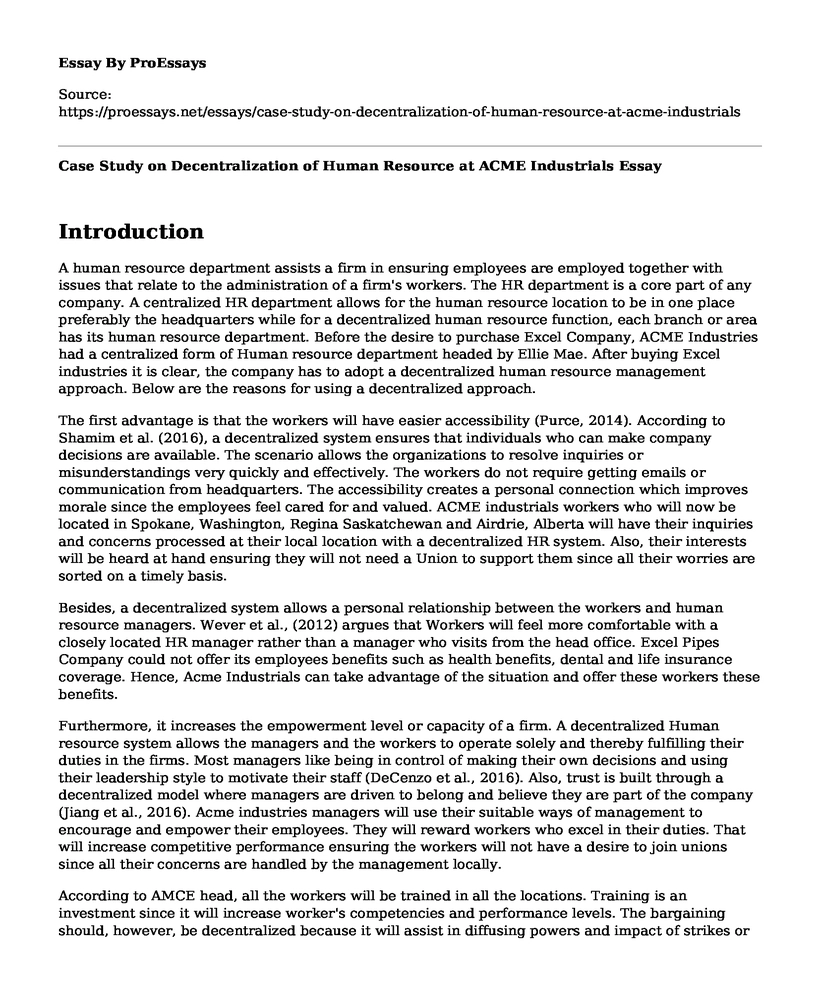Introduction
A human resource department assists a firm in ensuring employees are employed together with issues that relate to the administration of a firm's workers. The HR department is a core part of any company. A centralized HR department allows for the human resource location to be in one place preferably the headquarters while for a decentralized human resource function, each branch or area has its human resource department. Before the desire to purchase Excel Company, ACME Industries had a centralized form of Human resource department headed by Ellie Mae. After buying Excel industries it is clear, the company has to adopt a decentralized human resource management approach. Below are the reasons for using a decentralized approach.
The first advantage is that the workers will have easier accessibility (Purce, 2014). According to Shamim et al. (2016), a decentralized system ensures that individuals who can make company decisions are available. The scenario allows the organizations to resolve inquiries or misunderstandings very quickly and effectively. The workers do not require getting emails or communication from headquarters. The accessibility creates a personal connection which improves morale since the employees feel cared for and valued. ACME industrials workers who will now be located in Spokane, Washington, Regina Saskatchewan and Airdrie, Alberta will have their inquiries and concerns processed at their local location with a decentralized HR system. Also, their interests will be heard at hand ensuring they will not need a Union to support them since all their worries are sorted on a timely basis.
Besides, a decentralized system allows a personal relationship between the workers and human resource managers. Wever et al., (2012) argues that Workers will feel more comfortable with a closely located HR manager rather than a manager who visits from the head office. Excel Pipes Company could not offer its employees benefits such as health benefits, dental and life insurance coverage. Hence, Acme Industrials can take advantage of the situation and offer these workers these benefits.
Furthermore, it increases the empowerment level or capacity of a firm. A decentralized Human resource system allows the managers and the workers to operate solely and thereby fulfilling their duties in the firms. Most managers like being in control of making their own decisions and using their leadership style to motivate their staff (DeCenzo et al., 2016). Also, trust is built through a decentralized model where managers are driven to belong and believe they are part of the company (Jiang et al., 2016). Acme industries managers will use their suitable ways of management to encourage and empower their employees. They will reward workers who excel in their duties. That will increase competitive performance ensuring the workers will not have a desire to join unions since all their concerns are handled by the management locally.
According to AMCE head, all the workers will be trained in all the locations. Training is an investment since it will increase worker's competencies and performance levels. The bargaining should, however, be decentralized because it will assist in diffusing powers and impact of strikes or go-slows by the workers. For instance, if workers at Spokane, Washington are striking the others at Regina, Saskatchewan might not be striking since the conditions are different based on the work agreements. Decentralization of human resource allows for different working conditions or benefits, and the employers can determine these conditions because they understand the employees intimately.
However, the ACME industries should have a Human resource head at the headquarters who receives a report from all other locations and advise accordingly since there might be other decisions that require the CEO to push to all employees.
References
DeCenzo, D. A., Robbins, S. P., & Verhulst, S. L. (2016). Fundamentals of Human Resource Management, Binder Ready Version. John Wiley & Sons.
Jiang, K., Lepak, D. P., Hu, J., & Baer, J. C. (2012). How does human resource managementinfluence organizational outcomes? A meta-analytic investigation of mediatingmechanisms. Academy of management Journal, 55(6), 1264-1294.
Laursen, K., & Foss, N. J. (2014). Human resource management practices and innovation. TheOxford Handbook of Innovation Management, Oxford University Press, Oxford, 506-529.
Purce, J. (2014). The impact of corporate strategy on human resource management. NewPerspectives on Human Resource Management (Routledge Revivals), 67.
Shamim, S., Cang, S., Yu, H., & Li, Y. (2016, July). Management approaches for Industry 4.0: Ahuman resource management perspective. In 2016 IEEE Congress on EvolutionaryComputation (CEC) (pp. 5309-5316). IEEE.
Wever, L., Glaser, M., Gorris, P., & Ferrol-Schulte, D. (2012). Decentralization and participationin integrated coastal management: Policy lessons from Brazil and Indonesia. Ocean &coastal management, 66, 63-72.
Cite this page
Case Study on Decentralization of Human Resource at ACME Industrials. (2022, Dec 05). Retrieved from https://proessays.net/essays/case-study-on-decentralization-of-human-resource-at-acme-industrials
If you are the original author of this essay and no longer wish to have it published on the ProEssays website, please click below to request its removal:
- Influence of Social Class on Politics Essay
- Annotated Bibliography on Learning Communities
- Essay Sample on Managing Emergencies and Crisis
- Should Homosexuals Be Allowed to Marry? Annotated Bibliography
- Essay Sample on Helping Professions Issues
- Essay Example on Comparing Corporate Bonds to Government Bonds: Risks & Rewards
- Essay Example on Stereotypes: Impact on Self-Concept in Ingroup Experts & Peers







